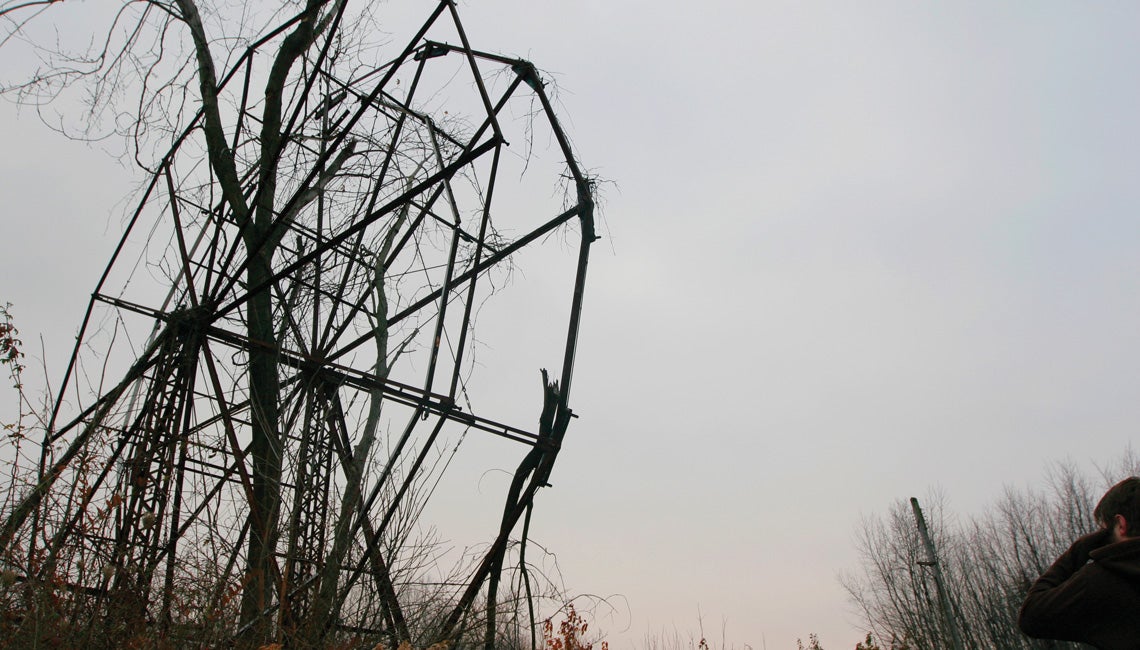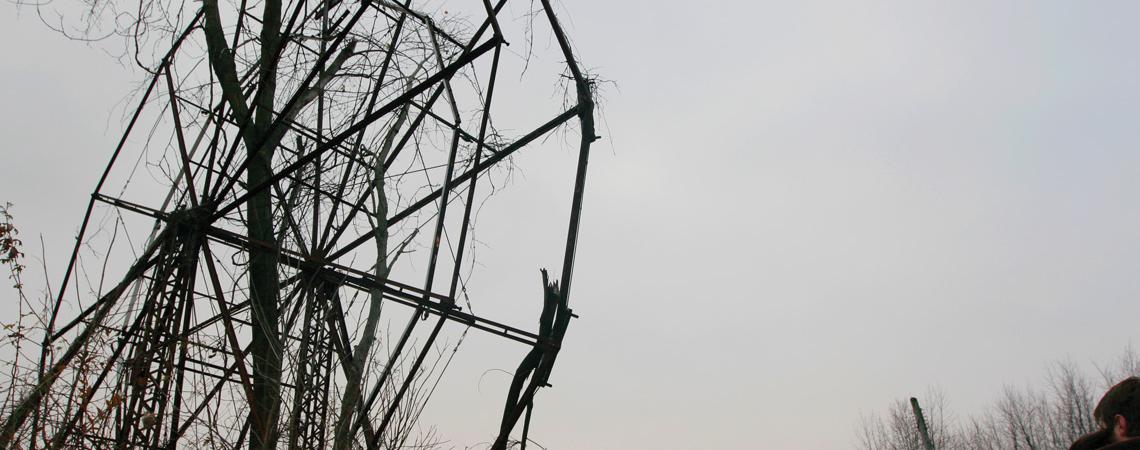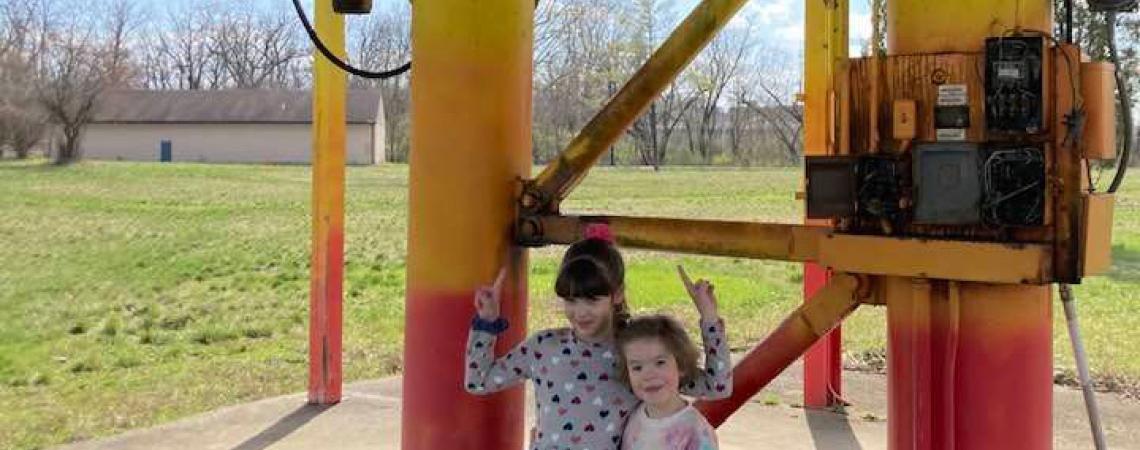Theme parks never really die. Even long after the exuberant screams of happy thrill-seekers have faded and the last caramel corn has been munched, if you find the right spot, you can still almost hear the sounds of the midway and even recognize some of the physical remains of long-abandoned amusement rides that may have entertained generations of carnival-goers past ...
Perhaps no state — except maybe Florida — is more synonymous with amusement parks than Ohio. Cedar Point to the north and Kings Island to the south draw millions of visitors each year and are among the top theme parks in the world.
A rusting old Ferris wheel, gradually being obscured by the surrounding forest, was one of the last surviving bits of evidence of the former Chippewa Lake Amusement Park in Medina County (photo by Dana Beveridge/via Flickr).
Amusement parks in Ohio date as far back as the mid-1800s. In fact, Cedar Point originally opened as a public beach in 1870. Kings Island, while celebrating its 50th anniversary this summer, traces its origins to nearby Coney Island, which also opened originally in 1870.
They are far from the only parks to open and close within the Buckeye State. Along with the 15 or so parks in operation today, the National Amusement Park Historical Association lists nearly 100 “lost” amusement parks in Ohio. Jeffrey Stanton, who runs the website www.lostamusementparks.napha.org, says that smaller parks couldn’t compete with the larger ones.
“The younger generation likes only thrill rides, so the big parks remove the older rides that once appealed to my generation and add only thrill rides,” Stanton says. The smaller parks didn’t have the budget to compete, he says, and it didn’t help that the land they occupied became more valuable than the dollars they could generate.
“So rather than make $50,000 a year running the park, some developer offers $10 million for the land,” Stanton says.
These amusement parks weren’t just places for families to spend a day in the sun; they also provided first summer jobs for countless kids, from lifeguards to ride supervisors. Carolyn Enderson, 52, remembers working for nine summers — from when she was 16 to age 24 — at Americana Amusement Park outside of Monroe. The park was a rumpled, smaller alternative to the flashier Kings Island, not 20 miles away, with an adjacent park called Fantasy Farm — complete with farm animals and barn-themed rides. Americana was a place for families and corporate picnics, where July days crawled by, and guests bought frozen bananas on a stick to battle
the heat.
“I liked making new friends each season and meeting lots of people each day,” Enderson says. “I think I prefer the small parks. It’s not so busy, and you can enjoy walking around because it’s smaller.”
“My first memory of Americana was back when it was called LeSourdsville Lake,” remembers Linda Nienaber. “It was in the spring of 1970, toward the end of first grade. We had a great time there. I remember sliding down a giant slide, riding on the mini roller coaster, and having a picnic on the grounds for our lunch. A couple of years later, my family and I went there for my dad’s company picnic. That was the first time I rode on the roller coaster with my older sister.”
One of the biggest and best parks of its day was Woodsdale Island Park, located on a now-long-gone island in the Great Miami River. The late Trenton historian Doris Page often talked of the park as the Kings Island of its day, according to her son, Gary Page, drawing tourists by train from Cincinnati and Dayton to its wooded banks. In its heyday, it boasted a restaurant, merry-go-round, boathouse, and other entertainment amenities.
Few people are around today, however, who even know exactly where that park stood — it was wiped out during the great flood of 1913, and the river’s fickle channel has changed often over the years.
“I’ve talked to others about the location — no one can give me an answer,” Page says. “I believe the river channel has moved so many times over the years, it’s hard to imagine that there was an island in the river.”
Farther north, on the western edge of Dayton in what is now Possum Creek MetroPark, the crumbling remains of a dance floor and rusting hulks of old street cars sit silent sentinel at the site of what used to be Argonne Forest Park. Steps to the park’s old swimming pool can still be seen.
Michele Taggart of Youngstown recalls Idora Park, one of the nation’s only urban amusement parks, which operated on the south side of town from 1899 until 1984.
“It was so fun — they even had a lion’s mouth on the garbage can, so it was fun to throw away trash,” Taggart says.
Chippewa Lake Amusement Park in Medina County has proved nearly impossible to kill off. It operated for a century, beginning in 1878 with a roller coaster that had to be manually pushed to the top of the first hill. After the park closed in 1978, it sat largely intact as nature and the elements took their toll. Today, the skeletons of a few old rides and buildings still haunt the now-overgrown park, but the Medina County Park system owns the land, with plans to open it as a public park and wetland. Some old park structures will survive as historical homage.
Mary Boulton grew up in Brunswick, Ohio, and remembers the park well.
“I remember when my family, including five siblings, made our yearly trek to Chippewa Lake Amusement Park,” she says. “My dad’s company picnic was held there every summer. We all looked forward to that yearly event, and it would be the one time a year we could catch up with old friends and make new ones.”












